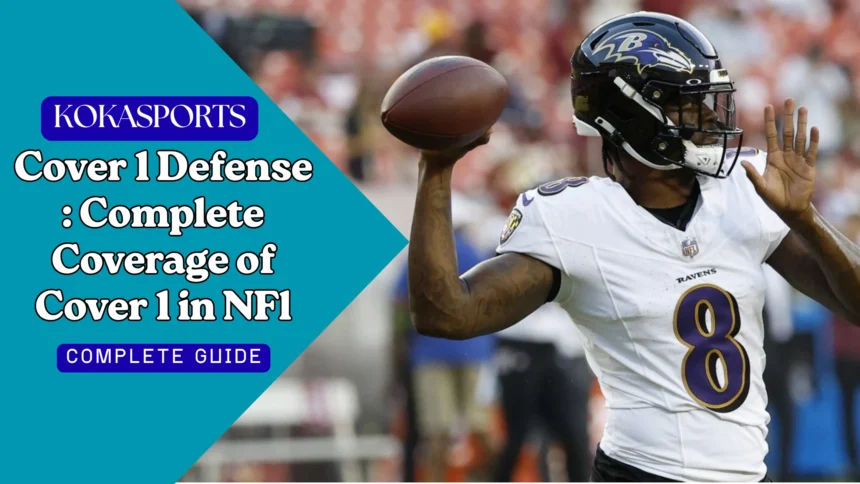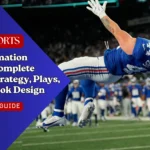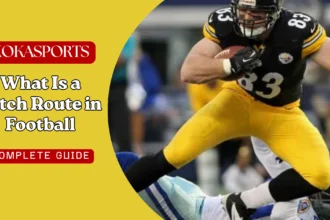When you watch an NFL game and see a quarterback scrambling under pressure while defenders stick to receivers like glue, there’s a good chance you’re witnessing cover 1 in action. This defensive scheme has become one of the most popular and aggressive coverages in modern football, and for good reason. Cover 1 combines the tenacity of man-to-man coverage with the safety net of a deep safety hovering over the middle of the field, creating a balanced approach that can disrupt even the most talented offenses.
In this comprehensive breakdown, we’ll explore everything you need to know about cover 1 defense from its basic principles to advanced variations like the 1 robber concept. We’ll dive into film room analysis, examine how teams like the Buffalo Bills deploy this coverage, and reveal the strategies offenses use to beat it. Whether you’re a coach, player, or football enthusiast preparing for the NFL draft, understanding cover 1 is essential to mastering the chess match between offense and defense.
What Is Cover 1?
Cover 1 is a defensive coverage scheme where defenders play man coverage on all eligible receivers while one safety stays deep to provide help over the top. Think of it as putting your best athletes on an island against the offense’s skill players while keeping an insurance policy in the back end. The free safety serves as the last line of defense, responsible for protecting the deep middle of the field and preventing big plays.
The basic alignment looks like this: cornerbacks line up across from wide receivers, linebackers match up with running backs or tight ends, and the free safety positions himself about 12-15 yards deep, reading the quarterback’s eyes and reacting to threats. Unlike cover 2, which uses two safeties deep, or cover 3, which employs zone coverage with three deep defenders, cover 1 puts maximum pressure on individual defenders to win their matchups.
What makes cover 1 unique in coverage in football is its aggressive nature. Because you only have one safety deep, defenses can bring an extra rusher or blitz from various angles, making life difficult for the quarterback. This is why you’ll often see cover 1 paired with five or six-man pressure packages the defense is betting that they can get to the quarterback before receivers break free from their coverage.
Key characteristics of cover 1:
- Single high safety alignment
- Man coverage on all eligible receivers
- Extra defender available for pass rush or spy
- High-risk, high-reward philosophy
- Requires excellent athlete ability from defensive backs
Read More: How Many Players on a Football Team? Complete Guide to Football Rosters and Positions
Cover 1 Defense Explained
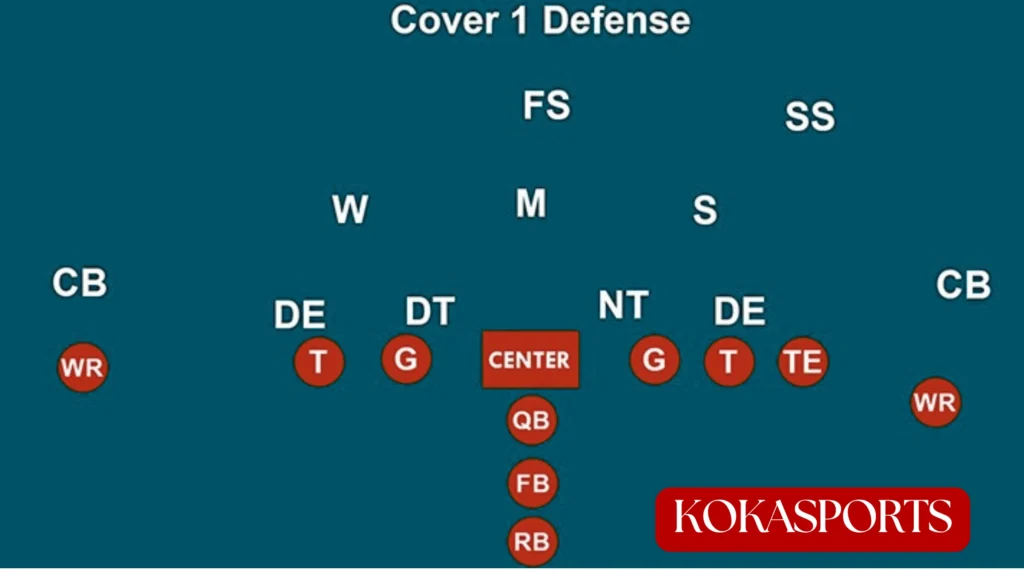
The cover 1 defense operates on a simple but demanding principle: win your individual battles. Each defender has a specific assignment that requires discipline, technique, and communication. Let’s break down each position’s responsibility in this coverage scheme.
Cornerbacks face perhaps the toughest job. They’re typically matched up against the opponent’s best receivers in press coverage, meaning they line up right at the line of scrimmage and attempt to disrupt the receiver’s route from the snap. Good cornerback play in cover 1 requires a combination of physicality, speed, and anticipation. They need to maintain inside leverage (staying between the receiver and the middle of the field) while trusting that the deep safety will help if a receiver breaks past them vertically.
Linebackers in cover 1 usually draw man-to-man coverage assignments on running backs or tight ends coming out of the backfield. This is where matchups become critical. If an offense has a speedy running back or athletic tight end, linebackers must have the speed and agility to stay with them in space. Some defenses adjust by having a defensive back or nickel cornerback take these assignments instead.
The strong safety in cover 1 has a flexible role depending on the defensive coordinator’s philosophy. Sometimes he plays like an extra linebacker in the box, providing run support or taking a man to man assignment on a tight end. Other times, he might have a robber or lurk responsibility, which we’ll discuss in the variations section. His versatility makes him crucial to the scheme’s success.
The free safety is the quarterback of the secondary in cover 1. Positioned as the deep safety, he must read the quarterback’s eyes, recognize route combinations, and react quickly to provide help. His job is to prevent any throws over the top and rally to the ball on intermediate routes. Great free safeties in cover 1 make quarterbacks think twice before testing the deep ball and can create interceptions by jumping routes.
One crucial element often overlooked is the pass rush. Because cover 1 is man coverage, plays tend to develop longer than in zone schemes. This means defenders need to cover receivers for extended periods, making an effective pass rush absolutely essential. Teams running cover 1 effectively typically have dominant pass rushers who can get home quickly.
Variations of Cover 1 Defense
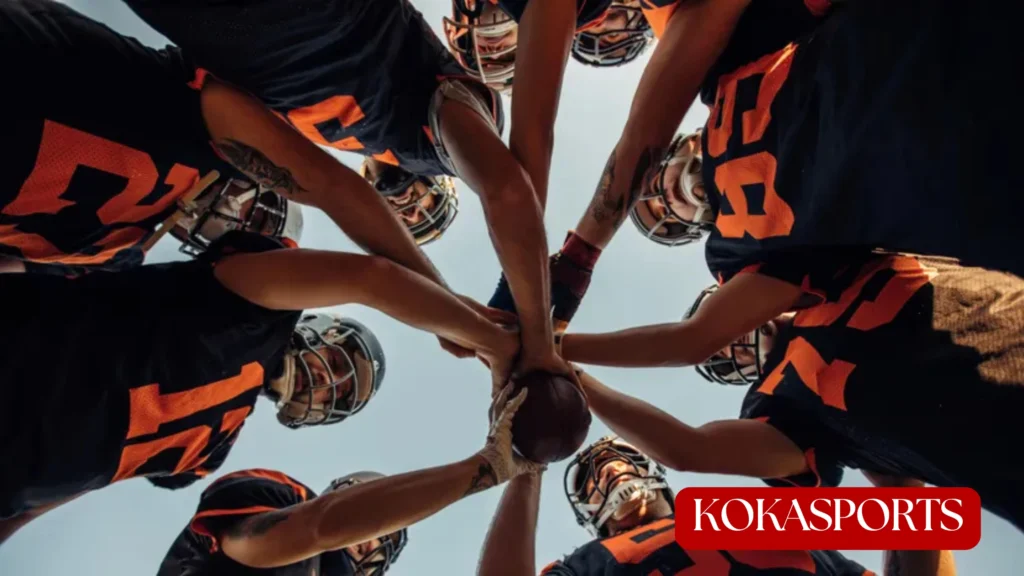
While the basic cover 1 concept is straightforward, defensive coordinators have developed several variations of cover 1 to keep offenses guessing and address specific weaknesses. These tweaks maintain the man coverage foundation while adding strategic elements to defend against common attacking concepts.
Cover 1 Robber
The cover 1 robber is perhaps the most popular variation you’ll see in today’s NFL. Instead of having both safeties play traditional roles, one safety (usually the strong safety) becomes a “robber” who drops into a shallow zone in the middle of the field. This defender reads the quarterback and sits underneath potential crossing routes or looks to jump intermediate throws.
The robber concept is brilliant because it gives the defense zone help in the most dangerous area—the middle of the field where crossing routes converge. The robber defender doesn’t have a specific man assignment; instead, he reacts to the quarterback’s intentions and can make game-changing plays by intercepting passes or disrupting timing routes. This variation is particularly effective against spread offenses that rely on quick, horizontal passing concepts.
Cover 1 Hole
Cover 1 hole (or 1 hole) assigns a linebacker or safety to hover in the “low hole” the area about 5-8 yards deep in the middle of the field. This defender sits in a zone and looks to disrupt slant routes, quick posts, or shallow crosses that target the soft spot between the underneath defenders. It’s similar to robber coverage but focuses on a shallower area of the field.
This variation helps defenses combat offenses that attack with quick timing routes designed to beat press coverage. The hole defender acts as a deterrent, making quarterbacks hesitant to throw into that area even if their receiver appears open coming out of his break.
Cover 1 Zone Hybrid
Some defenses incorporate elements of zone coverage into their cover 1 framework, creating a hybrid scheme. For example, they might play man coverage on the outside receivers while using zone principles for underneath defenders covering running backs or tight ends. This gives defenses some of the benefits of zone (better run support, fewer mismatches) while maintaining the aggressive nature of man coverage on the perimeter.
Cover 1 vs Cover 2 and Cover 3
Understanding how cover 1 differs from other common coverages helps clarify its strategic purpose. Cover 2 uses two safeties deep, splitting the field into halves and typically playing zone coverage underneath. This provides better deep protection but leaves more space in the intermediate areas.
Cover 3 employs three deep defenders (two corners and a safety) playing zone coverage, with four defenders underneath. This scheme offers excellent deep coverage but can be vulnerable to vertical stretches and requires defenders to cover more ground.
Cover 1 trades some of that deep security for aggression and pressure. It’s about attacking the offense rather than reacting to it, which is why you’ll see it frequently on third-and-long situations or when defenses want to force quick decisions from the quarterback.
Cover 1 in Action – Film Room Breakdown
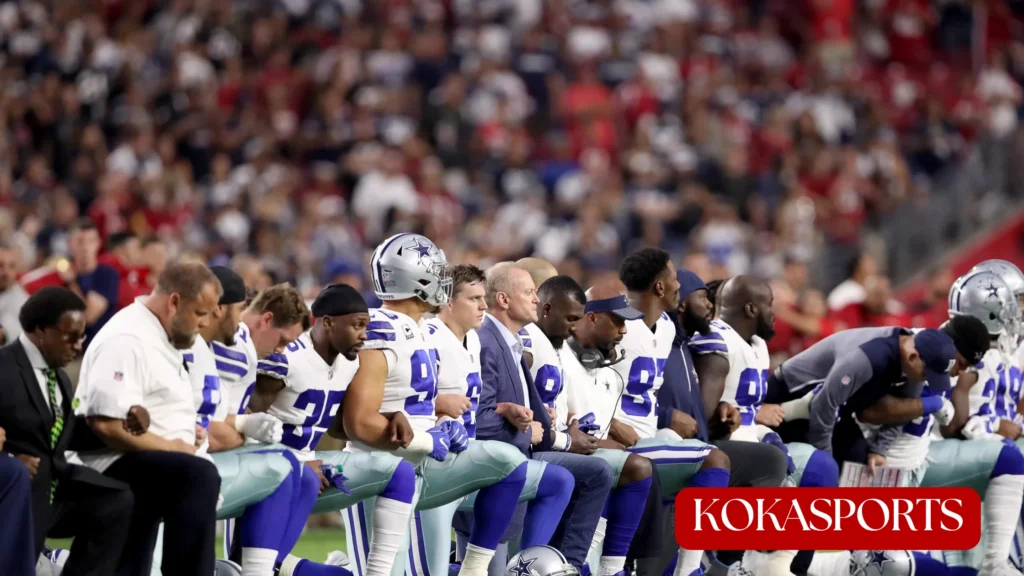
Watching cover 1 unfold on television is one thing, but understanding it through detailed film breakdowns reveals the nuances that separate good defenses from great ones. Analysts like Greg Tompsett have provided invaluable insights into how elite teams execute this coverage.
Greg Tompsett and the Buffalo Bills Film Room
The Buffalo Bills under defensive coordinator Leslie Frazier became known for their aggressive use of cover 1, and film room analysis by experts like Greg Tompsett has highlighted why their approach worked so effectively. The Bills combined excellent cornerback play with creative pressure packages, trusting their secondary to win matchups while bringing heat from unexpected angles.
What made the Bills’ cover 1 special was their ability to disguise it pre-snap. They’d show different looks sometimes appearing to be in cover 2 or cover 3 before rotating into cover 1 at the snap. This deception prevented quarterbacks from identifying the coverage early and adjusting their protections accordingly. The safety in the middle would often start near the line of scrimmage, making the offense think they were bringing a blitz, only to drop into his deep center field position at the last second.
Greg Tompsett’s breakdown emphasized how the Bills’ cornerbacks used their physicality at the line of scrimmage to disrupt timing routes while trusting their speed to recover if receivers got past the initial contact. This press-man technique is essential for successful cover 1 execution, as it buys time for the pass rush to reach the quarterback.
Matchups and Adjustments
Smart defensive coordinators understand that cover1 isn’t a one-size-fits-all solution. They study opponent personnel and identify favorable matchups they can exploit. For example, if a team has a slower wide receiver as their third option, the defense might feel comfortable leaving their nickel cornerback on an island against him.
Conversely, if facing an elite receiver who consistently wins one-on-one battles, defenses might adjust by giving that player a double team look or rolling coverage to his side while maintaining cover 1 principles everywhere else. These subtle adjustments showcase the chess match between coordinators and demonstrate why understanding personnel is just as important as understanding scheme.
How to Play Cover 1
Successfully executing cover 1 requires more than just understanding assignments—it demands precise technique, excellent communication, and exceptional athletic ability. Let’s break down what each position needs to do to play cover 1 effectively.
Player Responsibilities
Cornerbacks must master press-man technique, which means getting their hands on receivers at the line of scrimmage to disrupt routes while maintaining proper leverage. They should funnel receivers inside toward help rather than allowing them to run free outside. Footwork is critical; corners need to stay in phase with receivers, matching their speed and direction without getting beaten vertically. They must also communicate with the free safety about which receiver poses the deep threat.
Linebackers face unique challenges covering skill position players in space. They need to understand route concepts and anticipate where their assignment is going rather than simply reacting. Against a running back, linebackers should stay patient at the line of scrimmage to help with run support before releasing into coverage when pass develops. Physical linebackers who can jam tight ends at the line give their team a huge advantage.
The free safety must be a student of the game, recognising formations and tendencies to anticipate where the ball might go. Pre-snap, he communicates adjustments and ensures everyone understands their assignments. Post-snap, he reads the quarterback while maintaining depth, never allowing anyone to get behind him. Great free safeties develop instincts for when to break on the ball versus when to stay patient.
Pass rushers understand their responsibility extends beyond just sacking the quarterback. Even pressuring the quarterback into a rushed throw accomplishes the goal. Defensive ends must set the edge against the run while also winning one-on-one pass rush battles. Interior rushers need to collapse the pocket and prevent the quarterback from stepping into throws.
Common Mistakes in Cover 1
Even well-coached teams make errors executing cover 1 that lead to big plays. The most catastrophic mistake is when the free safety bites on a play-action fake or pump fake, leaving the deep middle undefended. Offenses specifically design concepts to manipulate that single high safety, and disciplined safeties don’t take the bait.
Cornerbacks sometimes lose leverage in press coverage, allowing receivers to get inside position and creating easy throwing lanes to the middle of the field. Or they might be too aggressive at the line, lunging at receivers and getting beaten with speed moves or double moves. Patience and proper technique prevent these breakdowns.
Linebackers occasionally get caught peeking into the backfield on play-action instead of honoring their coverage responsibilities. When a linebacker hesitates to release into coverage on his assigned receiver, it creates wide-open throwing windows underneath that quarterbacks exploit mercilessly.
| Position | Primary Responsibility | Key Technique | Common Mistake |
|---|---|---|---|
| Cornerback | Man coverage on WR | Press-man technique | Losing inside leverage |
| Linebacker | Man coverage on RB/TE | Patient release to coverage | Peeking at play-action |
| Free Safety | Deep middle help | Read QB eyes | Biting on fakes |
| Strong Safety | Box support/robber | Versatility | Unclear assignment |
| Pass Rush | Pressure quarterback | Winning 1-on-1 | Poor rush lanes |
How to Beat Cover 1 Defense
Offenses have developed sophisticated strategies to attack cover 1, exploiting its inherent weaknesses while challenging its strengths. Understanding these concepts helps both offensive coaches design effective game plans and defensive coaches prepare their units for what they’ll face.
Offensive Strategies
The most effective way to attack cover 1 is through crossing routes that create natural picks and rubs within the coverage. When receivers cross paths, defensive backs can get tangled up trying to follow their man, creating brief windows of separation. Mesh concepts, where two receivers cross at shallow depths, are particularly effective because they force defenders to communicate and potentially switch assignments.
Motion is another powerful tool against cover 1. Pre-snap motion helps offenses identify whether they’re facing man or zone coverage (defenders will typically move with receivers in man coverage). It also creates favorable matchups, such as getting a speedy slot receiver matched up against a slower linebacker who has to travel across the formation.
Running back routes are gold against cover 1 because linebackers often struggle covering backs in space. Wheel routes, where a back releases outside and runs vertically up the sideline, stress linebackers’ speed and create isolated matchups. Offenses can also run option routes with backs, allowing them to find open grass based on what the coverage does.
Cover 1 Beaters and Concepts
Certain route combinations have proven particularly effective against cover 1. The slant-flat combination attacks the area where the corner and linebacker meet, creating a two-on-one scenario. Post-wheel combos stress the free safety’s ability to cover two vertical threats. Four verticals concepts challenge cover 1 by putting five receivers against four underneath defenders and one deep safety someone will be open if the quarterback has time.
Play-action passes are devastating against aggressive cover 1 defenses. When the free safety bites on the run fake, it opens up deep shots behind him. Smart offenses use play-action on early downs when defenses expect run, catching them in aggressive run-support alignments.
Quarterback Tips
Quarterbacks facing cover_1 should first identify the single high safety pre-snap. Seeing one safety deep in the middle immediately tells them to expect man coverage. They can then look at how defenders are aligned press coverage on receivers, linebackers creeping toward the line to confirm the coverage.
During the play, quarterbacks should look off the free safety, using their eyes to manipulate him away from their intended target. If the safety cheats toward one side, that opens up the opposite side for big gains. Quick decision-making is essential because defenders will be tight in coverage, and windows close fast in man coverage.
Is Cover 1 Man or Zone?
This question confuses many people learning football, and the answer is: cover 1 is primarily man coverage with a zone element. Every defender except the free safety has a specific man-to-man assignment, following that player wherever he goes. The free safety plays a zone, responsible for the deep middle portion of the field rather than a specific receiver.
The confusion arises because people hear “cover” and think zone, but coverage schemes describe both man and zone concepts. Cover 1 gets its name from having one safety deep, not from being a zone coverage. When coaches talk about a 1 robber concept, they’re adding a zone robber element to the primarily man coverage scheme, creating a hybrid approach.
Understanding this distinction matters because it affects how offenses attack the defense. Against pure zone coverage, quarterbacks read defenders and throw to open spaces. Against man coverage, they’re attacking specific matchups and timing windows. Cover 1 presents characteristics of both, which is part of what makes it effective.
Common Questions About Cover 1
What is the difference between Cover 0 and Cover 1? Cover 0 is pure man-to-man coverage with no deep safety help. It’s the most aggressive coverage possible, essentially putting every defender on an island with zero deep help. Cover 1 adds that critical free safety over the top, providing an insurance policy against deep passes. Teams use Cover 0 primarily in obvious passing situations when they need to bring maximum pressure with a blitz.
When should you use Cover 1? Cover 1 works best in situations where you want to pressure the quarterback while maintaining adequate deep coverage. Third-and-long scenarios are ideal because offenses need significant yardage and you can bring pressure while your secondary has time to cover. It’s also effective against teams that struggle with man coverage or when you have superior athletes in your secondary who can win individual matchups.
What are the weaknesses of Cover 1? The primary vulnerability is when offenses create favorable matchups, such as a fast slot receiver against a linebacker. Athletic tight ends running vertical routes also challenge linebackers’ coverage abilities. The single high safety can be manipulated with route combinations that stress him to cover multiple threats. Finally, if the pass rush doesn’t get home quickly, defenders must cover for extended periods, increasing the likelihood someone breaks free.
Beyond Football :Other Uses of “Cover 1”
While our focus has been football, the term “Cover 1” appears in other contexts worth briefly mentioning. In electrical and industrial applications, a “While-in-Use Weatherproof Cover 1 Gang” refers to protective covers for outdoor electrical outlets that keep devices safe from weather while in use. These covers are essential for outdoor power applications and have nothing to do with football strategy.
Similarly, “Cover 1” might refer to insurance products, particularly travel insurance plans where “Cover 1” could be a basic tier of protection. In home decor, you might encounter “Chair Cover 1 Square” referring to furniture coverings. These alternative meanings remind us that context matters when football fans say cover 1, they mean aggressive defensive coverage, not electrical equipment!
Conclusion
Despite evolving offensive schemes, cover 1 remains a defensive staple from high school to the NFL. Its perfect balance of aggression and deep protection, combined with flexible variations like robber and hole concepts, makes it adaptable to any opponent. The scheme rewards athletic talent and forces offenses into quick decisions under pressure.
For aspiring coaches and players, mastering cover 1 is essential. Study film breakdowns and understand its strengths and weaknesses. This defensive chess match represents football strategy at its finest, and as long as quarterbacks throw the ball, cover 1 will remain a vital weapon in every coordinator’s arsenal.
FAQs
What does Cover 1 mean?
Cover 1 is a defensive coverage with one deep safety and man-to-man coverage on all receivers underneath.
Why is cover 2 called cover 2?
Cover 2 gets its name from having two safeties playing deep zones, splitting the field into halves.
What is the weakness of Cover 1?
The main weaknesses are crossing routes, favorable matchups for offenses, and vulnerability if the pass rush doesn’t get home quickly.
Is Cover 1 always man?
Yes, Cover 1 is always man coverage underneath with one safety playing a deep zone over the top.
What is Cover 1 in football?
Cover 1 is a defensive scheme where defenders play man coverage while one safety provides deep middle help.
Is Cover 1 man or zone coverage?
Cover 1 is primarily man coverage with a single zone element—the free safety playing deep middle.
How do you play Cover 1 effectively?
Play Cover 1 effectively by using press-man technique, maintaining proper leverage, generating pass rush pressure, and having the free safety read the quarterback.
What’s the difference between Cover 1 and Cover 2?
Cover 1 uses one deep safety with man coverage underneath, while Cover 2 uses two deep safeties with zone coverage.
What are the best Cover 1 beaters?
The best Cover 1 beaters include crossing routes, mesh concepts, wheel routes from running backs, and four verticals with play-action.

